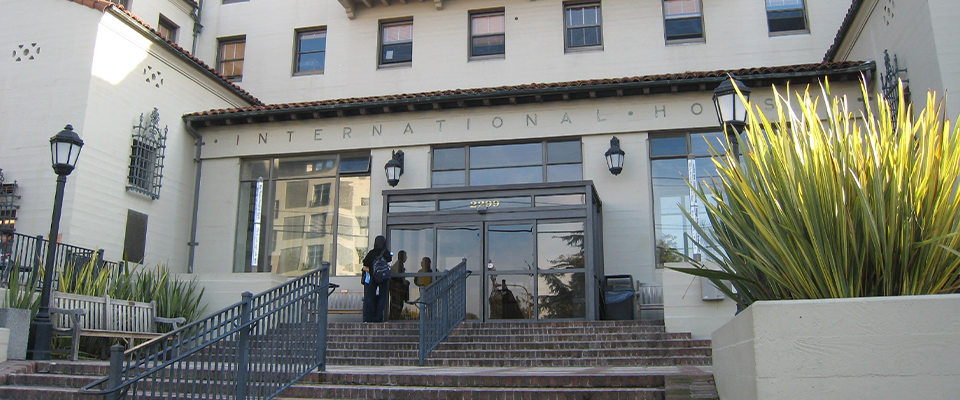Welcome to the United Nations of Berkeley.
FOR INTERNATIONAL HOUSE ALUMNA BERNICE TAJIMA, the days after February 19, 1942, were a race against the clock. President Roosevelt had just signed an executive order forcibly relocating people of Japanese descent from their West Coast homes to internment camps across the country. In this climate of extreme suspicion, UC Berkeley’s I-House protected its residents. With the help of I-House staff, Tajima transferred to Chicago’s I-House just in time and escaped internment. “I know that this would not have been possible if I had not lived at I-House Berkeley in the caring community of friends,” Tajima later wrote. “I can’t fully express in words my gratitude.”
Current Executive Director Hans Giesecke describes I-House as “an incubator of talent.” Entire universities are lucky to claim a single Nobel laureate, and I-House has eight.
From its inception, Berkeley’s I-House took a stand for inclusivity and cooperation. I-House founder Harry Edmonds arrived in Berkeley in 1926 to choose a location near campus for the future residence hall. Rejecting a site in North Berkeley (to him the “back door” to campus), Edmonds opted instead for Piedmont Avenue. At the time, Berkeley fraternities and sororities excluded foreigners and people of color. By choosing a location at the center of Greek life, Edmonds sought to strike bigotry “right hard in the nose.”
On August 18, 1930, I-House welcomed its first class of residents. It was the largest student housing complex in the Bay Area and the first coeducational residence west of the Mississippi. Benefactor John D. Rockefeller Jr. described the new residence hall as “a laboratory for a new kind of experiment—the day to day practice of international fellowship among men and women … a community of university students, representing all nations, living together under one roof.”
Ninety years later, with its distinctive red tile roof and domed tower, I-House is a fixture of the Berkeley landscape. Nearly 100,000 residents have gathered under the intricate hand-painted ceiling of the Great Hall, gazed at the Campanile and the bay from west-facing windows, and shared meals at the long tables of the dining hall.
Current Executive Director Hans Giesecke describes I-House as “an incubator of talent.” Entire universities are lucky to claim a single Nobel laureate, and I-House has eight. Additionally, the residence hall has been home to two California governors, more than 130 current Berkeley faculty members, and an impressive number of diplomats.

“People learn so much from one another in this building,” Giesecke says. “You have people who are in political science learning from the electrical engineers, and you have people in gender studies learning from people in chemistry. It goes across cultures; it goes across departments.”
Gavin McCormick, M.A. ’11, credits I-House’s peer-learning environment as key to the success of his company WattTime, a pioneer of automated emissions reduction technology that began in I-House’s Dining Commons. “We only could have been founded here at I-House,” McCormick said at a presentation he gave in 2017. While many other start-ups are founded by like-minded friends, McCormick attributes WattTime’s success to the unique diversity of ideas and backgrounds found at I-House.
Since I-House opened its doors, it remains invested in the idea that shared space and conversation hold the potential for something profound.
About 600 people live at I-House each semester, representing more than 75 countries and 100 areas of study. About 20 to 25 percent of residents are U.S. passport holders. Unlike other residence halls at Cal, I-House includes both undergraduate and graduate students.
I-House traditions include quarterly formal dinners known as Sunday Suppers and weekly Wednesday Coffee Hours. Students often volunteer to host events inspired by their home countries, teaching fellow residents about everything from henna tattoos to tapas. Valerie Ong, resident engagement manager, explained that students approach social life at I-House with intention: “The people that are living here choose to live here because they want this kind of opportunity to interact with people from everywhere.”
Since I-House opened its doors as a “laboratory” for the daily practice of international fellowship, it remains invested in the idea that shared space and conversation hold the potential for something profound. Although much has changed over the decades, Giesecke believes that I-House’s founding ideals of “respect, understanding, and mutual cooperation” continue to ring true.
Julia Apffel ’19 was a winter editorial intern at California.
From the Spring 2020 issue of California.




















